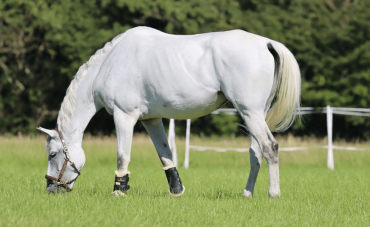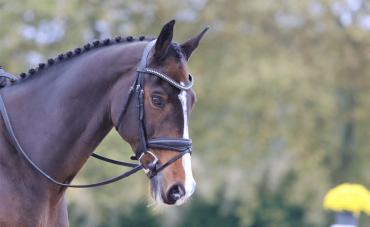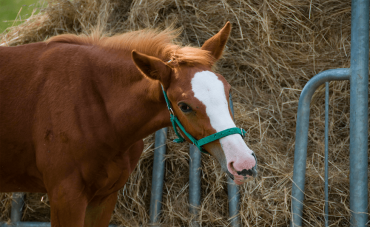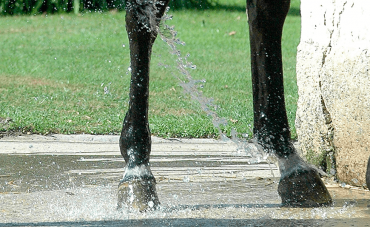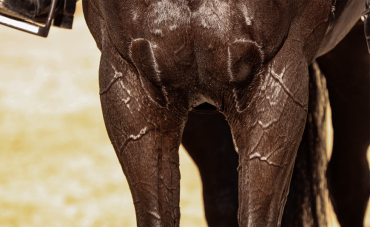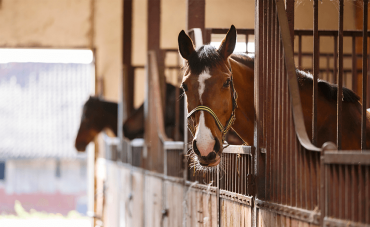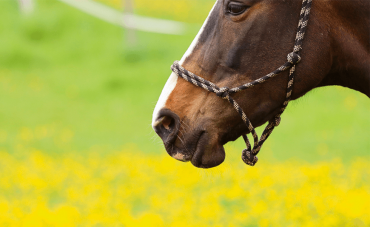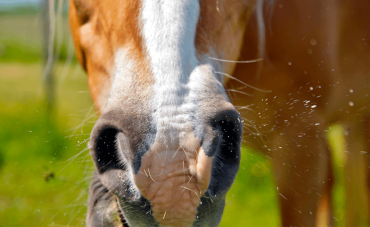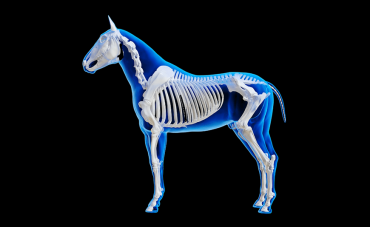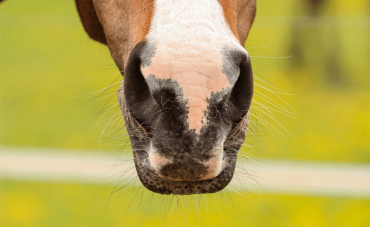Back problems are also known as dorsalgia. They are commonly experienced by horses. Dorsalgia can be caused by a bone-related condition that affects the spine, but it can also arise as a result of unsuitable work or bad back posture.
How can I know whether my horse has dorsalgia?
To figure out whether your horse has back pain, a very straightforward method is to simply run your hand over its back. If the horse reacts in pain, for example by arching its back, this is a sign of a dorsal issue. These signs can also become evident during grooming when brushing the horse’s back or when putting the saddle in place. Dorsalgia can also be noticed when you mount your horse. It may pin its ears, stiffen its body, and move its hindquarters back to relieve the pain.
This being said, however, dorsalgia may not always be so obvious. While your horse may not seem to be in pain when you touch its back, its performance might decrease, it might be less flexible, or it may even behave more defensively during certain exercises: stiffness while turning, refusing to jump obstacles, kicking, or bucking.
Dorsalgia can be diagnosed by your vet during your horse’s check-up. They will do back manipulation tests that make the horse contract certain muscles and use certain joints. This way, the vet will be able to identify painful areas or contractures that result in decreased dorsal mobility. Tension may also be applied to the vertebrae that make up your horse’s spine by using a surcingle, in order to detect back pain. The surcingle test is often performed when buying a horse to screen for or confirm back problems.
What are the different types and causes of dorsalgia?
Dorsalgia can have several different causes. It may be due to a bone-related or spinal condition in your horse.
The most commonly diagnosed condition is spinous process impingement. The spinous processes are the projections that jut out from the vertebrae. Each vertebra in the back has one, and they are not meant to touch one another. Some horses have a genetic conformation that results in the spinous processes being very close together. When these projections rub against each other, it leads to pain as well as bone sclerosis. The position of your horse’s head and neck also affects the distance between these processes. The higher the horse holds its head (resulting in a hollower back), the closer the spinous processes will get, to the point where they may end up rubbing against each other.
Another condition that can cause back pain, this time involving the joints, is arthritis between the vertebrae. The remodelling and reshaping of the horse’s bones caused by wear and tear can result in pain. These bone-related conditions can be diagnosed with an X-ray.
In the back, there is a ligament that runs along the vertebrae, known as the supraspinous ligament. As its name suggests, it links the supraspinous processes together. An inflammation of this ligament can lead to back pain in your horse. Your vet can diagnose this ligament-related condition via ultrasound.
Dorsalgia can also be caused by muscle pain. Muscle inflammation is caused by harmful positions during work, inappropriate exercise intensity, or a lack of warming up.
Finally, it is also important to keep in mind that some back pain comes from trying to compensate for other problems. Therefore, horses with arthritis in their hind legs, for example in their hocks, often suffer from dorsalgia. In this case, the horse would be trying to alleviate a joint problem involving its limbs. Treatments are available for this kind of arthritis. Some of these solutions act locally by only treating the affected joint, including corticosteroid injections, hyaluronic acid, PRP, IRAP, and stem cells, while others are able to treat all the joints affected by arthritis, such as bisphosphonates which act directly on bone remodelling.
How to treat and how
to prevent dorsalgia
Treatment for dorsalgia can act on different areas.
There are treatments that can relieve pain, while others act directly on certain mechanisms of the condition, such as bone remodelling.
Local treatments involve administering medication directly on or into the affected area. Corticosteroid injections near the affected vertebral joints or spinous processes help to relieve pain. It is also possible to inject medication directly into the skin on the horse’s back, which is known as mesotherapy.
Systemic treatments help to treat all the affected areas in the back. Pain-relieving products such as non-steroidal anti-inflammatory drugs can be used.
Other non-medicinal treatments, such as shock wave therapy, also exist.
Additionally, some nutritional supplements are able to alleviate back stiffness. Nutritional supplements made with white willow, boswellia, and quercetin, such as Ekyflex Nodolox, contribute to maintaining a flexible back and reducing stiffness in the area.
Osteopathy and stretching can also help to keep back problems in check in the context of certain cases of dorsalgia. Massaging the back before work to prepare the body for exertion, as well as afterwards to release tension, can also be beneficial.
All these elements should be paired with appropriate physical exercise to relieve pain, but also to build muscle in order to prevent pain from arising.
There are several ways to prevent dorsalgia. First and foremost, it is important to have the right material and a suitable saddle that will not cause tension in the back.
Daily work is also important, and it is necessary to adapt the horse’s exercises to build muscle in the back and abdomen. Warming up is essential, since it allows the body to prepare for physical exertion and to prevent working in a state of contraction and pain.
Don’t hesitate to ask your vet for advice.

